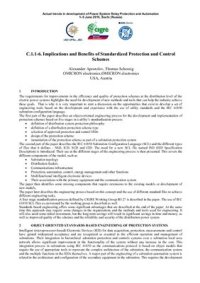
Ebook: Implications and Benefits of Standardized Protection and Control Schemes
- Genre: Technique // Energy
- Tags: Топливно-энергетический комплекс, Релейная защита и автоматизация ЭС
- Language: English
- pdf
Sigre 2015. — 7 с.
OMICRON electronics,OMICRON electronics
USA, AustriaThe requirements for improvements in the efficiency and quality of protection schemes at the distribution level of the electric power systems highlights the need for development of new methods and tools that can help the industry achieve these goals. That is why it is very important to start a discussion on the opportunities that exist to develop a set of engineering tools based on the development and experience with the use of utility standards and the IEC 61850 substation configuration language.
The first part of the paper describes an object-oriented engineering process for the development and implementation of protection schemes based on five stages in a utility’s standardization process:
- definition of distribution system protection philosophy
- definition of a distribution protection scheme type
- selection of approved protection and control IEDs
- design of the protection scheme
- instantiation of the protection scheme as part of a substation protection system
The second part of the paper describes the IEC 61850 Substation Configuration Language (SCL) and the different types of files that it defines - SSD, ICD, SCD and CID. The need for a new SCL file named ISD (IED Specification Description) is introduced. Their use at the different stages of the engineering process is then presented. This covers the different components of the model, such as:
- Substation topology
- Distribution feeders
- Communications infrastructure
- Protection, automation, control, energy management and other functions
- Multifunctional intelligent electronic devices
- Their associations with the primary equipment and the communication system
The paper then identifies some missing components that require extensions to the existing models or development of new models.
The paper later describes the engineering process based on this concept and the use of different standard files to achieve different engineering tasks.
A four stage standardization process defined by CIGRE Working Group B5.27 is described in the paper. The use of IEC 61850 SCL files as envisioned by the working group is described as well.
Standards based engineering offers some significant advantages that are described at the end of the paper. At the same time this approach may require some changes in the organizations and the methods and tools used for engineering. It will also need some initial investment, but the long term savings will result in significant savings in time and money, as well as improved quality of the schemes and the reliability and security of the distribution power system.
OMICRON electronics,OMICRON electronics
USA, AustriaThe requirements for improvements in the efficiency and quality of protection schemes at the distribution level of the electric power systems highlights the need for development of new methods and tools that can help the industry achieve these goals. That is why it is very important to start a discussion on the opportunities that exist to develop a set of engineering tools based on the development and experience with the use of utility standards and the IEC 61850 substation configuration language.
The first part of the paper describes an object-oriented engineering process for the development and implementation of protection schemes based on five stages in a utility’s standardization process:
- definition of distribution system protection philosophy
- definition of a distribution protection scheme type
- selection of approved protection and control IEDs
- design of the protection scheme
- instantiation of the protection scheme as part of a substation protection system
The second part of the paper describes the IEC 61850 Substation Configuration Language (SCL) and the different types of files that it defines - SSD, ICD, SCD and CID. The need for a new SCL file named ISD (IED Specification Description) is introduced. Their use at the different stages of the engineering process is then presented. This covers the different components of the model, such as:
- Substation topology
- Distribution feeders
- Communications infrastructure
- Protection, automation, control, energy management and other functions
- Multifunctional intelligent electronic devices
- Their associations with the primary equipment and the communication system
The paper then identifies some missing components that require extensions to the existing models or development of new models.
The paper later describes the engineering process based on this concept and the use of different standard files to achieve different engineering tasks.
A four stage standardization process defined by CIGRE Working Group B5.27 is described in the paper. The use of IEC 61850 SCL files as envisioned by the working group is described as well.
Standards based engineering offers some significant advantages that are described at the end of the paper. At the same time this approach may require some changes in the organizations and the methods and tools used for engineering. It will also need some initial investment, but the long term savings will result in significant savings in time and money, as well as improved quality of the schemes and the reliability and security of the distribution power system.
Download the book Implications and Benefits of Standardized Protection and Control Schemes for free or read online
Continue reading on any device:

Last viewed books
Related books
{related-news}
Comments (0)